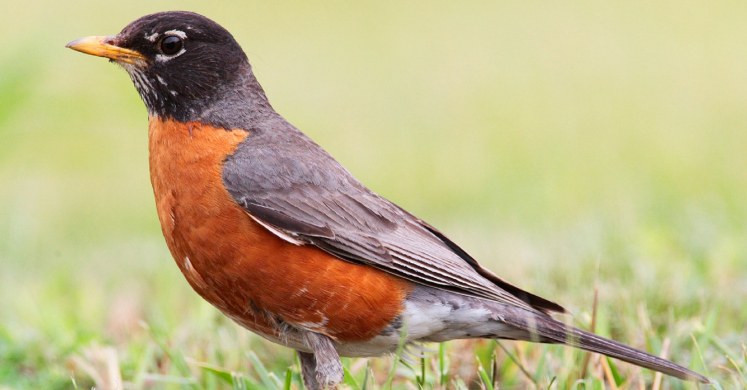Blog

#bioPGH Blog: The Rockin’ Robin
 A resource of Biophilia: Pittsburgh, #bioPGH is a weekly blog and social media series that aims to encourage both children and adults to reconnect with nature and enjoy what each of our distinctive seasons has to offer.
A resource of Biophilia: Pittsburgh, #bioPGH is a weekly blog and social media series that aims to encourage both children and adults to reconnect with nature and enjoy what each of our distinctive seasons has to offer.
Unaware that a predator was watching, a frog sat idly on its throne of mosses and leaf bits, its green, glistening skin reflecting any flecks of light like tiny amphibian crown jewels. Making only the slightest sound, the shadow-cloaked predator hopped the tiniest bit onto a branch to adjust the view of its quarry. Then suddenly, with a blur of grey and orange, the predator struck! The shiny green blurred with flying feathers, and suddenly, the story has a new protagonist. What followed was a combination of actions likely meant to “break up” the meal into a nice squishy slurp: the predator dropped the frog from heights, beat the frog against the ground, and generally did its best to mash up the big bite. It was apparently too big, though, even after all of that work. As mighty as the predator had proven itself to be, it couldn’t fit the frog all in one gulp, thus it didn’t eat the frog at all. And what was this impressive predator, swopping in for an ambitious meal? An American Robin.
That retelling of this paper documenting a robin preying on a frog may have been a bit dramatized, but I love when nature has quirky surprises in store. Over the past few weeks, the robins in my neighborhood have become more active in the mornings — singing early, calling loudly to other birds and flitting here and there in pursuit of the perfect nest site. They couldn’t be more indicative of spring even if they made porcelain versions of their perfectly delicate blue eggs. And yet, even as a hallmark of a season marked by gentle pastels, baby animals, and little blooms, robins are still a force to be reckoned with. Granted, frog depredation may not be robins’ default way of feeding themselves, but it’s a good reminder not take even our slightest wild creatures for granted. Let’s learn more about our little spring friends with a warrior streak, shall we?
The American robin is among the most abundant birds on the continent. Depending on the season, it ranges from northern Canada to Central America, and even though we see them year-round, as a species, they are actually migratory. During the winter, we in Pennsylvania are typically seeing robins from Canada and northern states, while our own robins have gone further south. In addition to having a wide geographic range, robins have also adapted to a wide range of habitat types, including heavily human-modified habitats like cities and suburbs. As we noted above, robins can indeed occasionally hunt comparatively large prey like frogs and small mammals, their staple foods are fruits and invertebrates, like insects, worms, and snails.
Within the next several weeks, our Pennsylvania robins will have begun tending to their first brood of the season. Robins tend to lay a clutch of eggs early in the spring, which gives them enough time to lay a second and sometimes even a third clutch of eggs as the summer goes on! Robins are also attentive parents, and they are among a notable group of birds who can correctly identify when a brood parasite, like a brown-headed cowbird, lays an egg in their nest hoping that unwitting parents will raise the “parasite” chick. Robins recognize the invader egg and know to reject it.
This time of year especially, robins are a vocal bunch, and if you are an “early bird,” you have undoubtedly heard them already. They have quite a variety of calls; listen to a few examples below!
So the next time we see our ubiquitous and seemingly innocuous friend the robin, let’s keep that although we see them every day, they can still surprise us and keep us guessing. Nature is wild!
Resources
Image Credits: Header, Wikimedia user Captain-tucker CC-BY-SA-4.0; Cover Wikimedia user Mdf, CC-BY-SA-3.0

